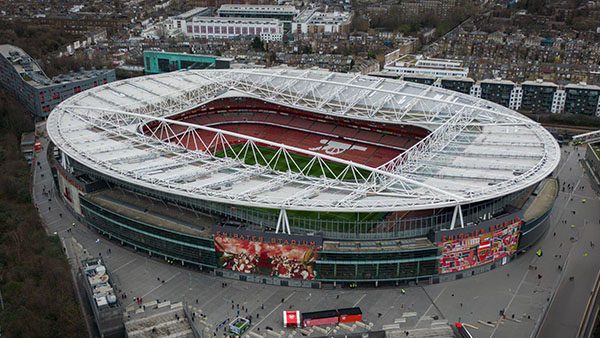The Emirates is perhaps a bittersweet symbol for Arsenal. The club’s Premier League dominance ended when Arsene Wenger was in charge and decamped from Highbury to the new, modern surroundings. Since their move to the Emirates, Arsenal have not won the Premier League trophy – but perhaps that will all change under Mikel Arteta this season.
Emirates Stadium Arsenal History – A Journey Through Time
Back in 1997, began the work to potentially move to a new stadium after Islington Council rejected plans to expand their home at the time, Highbury.
Arsenal even considered buying Wembley Stadium, but in 2000 they bought Ashburton Grove, previously used for industry and waste disposal, and were given permission to build their new stadium in 2001.
Planning continued but finances meant that no work started until 2004, with the stadium finished in 2006. The cost was £390 million, which left Arsenal with a loan of hundreds of millions of pounds to repay, partially offset by the Emirates sponsorship..
Highbury was turned into many apartments, which were used in part to finance their new stadium.
While Arsenal have always remained competitive in their attempts to reach the top four, it is only since Mikel Arteta’s arrival that they have again become serious challengers for the Premier League title.
The Emirates witnessed a great effort in 2023 only for them to fall short against Manchester City, but 2024 could see them finally christen the Emirates with a league title.
Emirates Stadium Arsenal Renovation – Shaping the Modern Jewel
In 2009, three years after Arsenal moved to the stadium, the club began a process of ‘Arsenalisation’ in order to make it more visibly part of the club’s culture.
There are now murals of 12 key moments in the club’s history, as voted for by fans. Two bridges near the stadium were named after club directors Danny Fiszman and Ken Friar.
In 2010, the quadrants of the stadium were renamed the East Stand, West Stand, North Bank and Clock End.
In December 2011, Arsenal built three statues of key figures in the club’s history: Tony Adams, Thierry Henry and former manager Herbert Chapman, for the club’s 125-year anniversary.
Emirates Stadium Arsenal Capacity – A Sea of Red and White
The Emirates Stadium boasts a capacity of 60,704, with the current attendance record set on November 2, 2019 in a game against Wolverhampton Wanderers set at 60,383. The pitch is 105 by 68 metres, and there are 152 executive suites.
The seats wrap around the whole stadium and there is a concerted effort from supporters group REDaction to provide banners and flags hung up before games. Not only that, a flag emblazoned with the number ‘49’ is passed around the lower tier before games, with 49 the number of games the Invincibles went unbeaten in the league before their controversial defeat to Manchester United.
Where is Emirates Stadium Arsenal? – Navigating the Heart of North London
The Emirates Stadium is located at Highbury House, 75 Drayton Park, London, and is well served by a number of public transport links.
The closest London Underground station is Arsenal Station for the north end, with the south end closest to Highbury & Islington Station, though that is because Holloway Road Station is entry-only before matches and exit-only afterwards, as it is not big enough to safely cope with demand from fans at peak times. Drayton Park Station is shut on matchdays. Finsbury Park, another major tube station, is also walking distance.
There are numerous bus stops around the stadium, and access by car is extremely difficult because of limited parking options, and the closure of roads on matchdays around kick-off and afterwards.
Matchday Traditions – Creating Memories at Emirates Stadium
Arsenal’s most fearsome atmospheres are reserved for their main rivals in the Premier League. North Londoners Tottenham often bring out the most caustic approaches from Arsenal, while both Chelsea and Manchester United have been bitter enemies at different periods of the last 20 years.
Arsenal fans, known as Gunners or Gooners, have several songs that they bring out through matches: One-Nil to the Arsenal, Who’s that team they call the Arsenal, Good Old Arsenal, and sometimes Boring, Boring Arsenal if they are playing especially well.
Gunnersaurus Rex, a huge green dinosaur, is their mascot.
Socios.com and Arsenal Fan Tokens – The Fan’s Voice
Arsenal Fan Tokens are digital assets that let you turn your support into rewards. As a Fan Token holder, you will get the chance to win once-in-a-lifetime opportunities, unique rewards, and other kinds of prizes that reward your passionate lifelong support for your team. Fan Tokens will let you take part in official club polls, predict results, check-in for games, play games, pick your favourite players and even more, all while earning reward points to help you win Fan Rewards, and perhaps even get them unique access to the Emirates Stadium.






